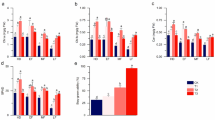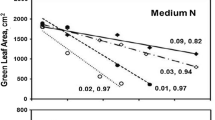Abstract
Functional stay-green has been regarded as a promising characteristic to be introduced for improving rice yield potential. A functional stay-green rice “SNU-SG1” that was identified from japonica rice collections was compared with two regular high-yielding rice cultivars (HYVs) for the temporal change of leaf chlorophyll, soluble protein, and root activity, and nitrogen accumulation and remobilization during the grain-filling period. SNU-SG1 had slower decreasing rate and maintained higher concentration of chlorophyll and soluble protein in upper four leaves during the grain-filling period than HYVs “Suweon490” and “Andabyeo”, revealing a typical stay-green characteristic. Even though SNU-SG1 remobilized almost the same proportion of N accumulated before heading as HYVs to grain, it maintained much higher leaf N concentration due to the significantly higher N accumulation that is ascribable to the higher root activity sustenance during grain-filling period. The functional stay-green trait of SNU-SG1 seems to stem not only from the genetic control preventing chlorophyll degradation but also from the higher capacity to absorb N from soil due to the sustained strong root activity during grain-filling period. SNU-SG1 exhibited higher crop growth rate during late grain-filling period than HYVs, resulting in higher grain-filling percentage and non-structural carbohydrate re-accumulation in the stem at the final stage of grain filling. It is concluded that SNU-SG1 has a promising trait “functional stay-green” contributable to rice yield potential improvement through the improved grain filling.
Similar content being viewed by others
References
Gwathmey CO, Hall AE, Madore MA. 1992. Adaptative attributes of cowpea genotypes with delayed monocarpic leaf senescence. Crop Sci. 32: 765–772
Luo P, Ren Z, Wu X, Zhang H, Zhang H, Feng J. 2006. Structural and biochemical mechanism responsible for the stay-green phenotype in common wheat. Chinese Sci. Bull. 51: 2595–2603
Mae T. 1997. Physiological nitrogen efficiency in rice: Nitrogen utilization, photosynthesis, and yield potential. Plant Soil 196: 201–210
Osaki M, Shinano T, Matsumoto M, Zheng T, Tadano T. 1997. A root-shoot interaction hypothesis for high productivity of field crops. Soil Sci. Plant Nutr. 43: 1079–1084
Park JH, Lee BW. 2003. Photosynthetic characteristics of rice cultivars with depending on leaf senescence during grain filling. Korean J. Crop Sci. 48: 216–223
Pommel B, Gallais A, Coque M, Quilleré I, Hirel B, Prioul JL, Andrieu B, Floriot M. 2006. Carbon and nitrogen allocation and grain filling in three maize hybrids differing in leaf senescence. Eur. J. Agron. 24: 203–211
Prioul JL, Reyss A, Schwebel-Dugué N. 1990. Métabolisme carboné dans les feuilles sources lors de la phase de remplissage des grains: recherche de critères de remobilisation et de senescence, In D Picard, éd, Physiologie et production du maïs, pp 239–244
SAS Institute. 2003. SAS Institute, SAS version 9.1, SAS Institute Inc., Cary, NC, USA
Spano G, Di Fonzo N, Perrotta C, Platani C, Ronga G. 2003. Physiological characterization of ’stay green’ mutants in durum wheat. J. Exp. Bot. 54: 1415–1420
Systat Software & Inc. 2004. Systat Software Inc., SigmaPlot version 9.0, Chicago, IL, USA
Thomas H, Howarth CJ. 2000. Five ways to stay green. J. Exp. Bot. 51: 329–337
Thomas H, Ougham H, Canter P, Donnison I. 2002. What staygreen mutants tell us about nitrogen remobilization in leaf senescence. J. Exp. Bot. 53: 801–808
Yang J, Zhang J, Wang ZH, Zhu Q, Wang W. 2001. Remobilization of carbon reserves in response to water deficit during grain filling of rice. Field Crops Res. 71: 47–55
Yoo SC, Cho SH, Zhang H, Paik HC, Lee CH, Li J, Yoo JH, Lee BW, Koh, HJ, Seo HS, Paek NC. 2007. Quantitative trait loci associated with functional stay-green SNU-SG1 in rice. Mol. Cells 24: 83–94
Zhang X, Tan G, Huang Y. 1994. Experimental Technology of Plant Physiology. Liaoning Science and Technology Press, Shenyang, China, pp 51–75
Author information
Authors and Affiliations
Corresponding author
Rights and permissions
About this article
Cite this article
Fu, JD., Yan, YF. & Lee, BW. Physiological characteristics of a functional stay-green rice “SNU-SG1” during grain-filling period. J. Crop Sci. Biotechnol. 12, 47–52 (2009). https://doi.org/10.1007/s12892-009-0078-8
Received:
Accepted:
Published:
Issue Date:
DOI: https://doi.org/10.1007/s12892-009-0078-8




